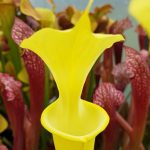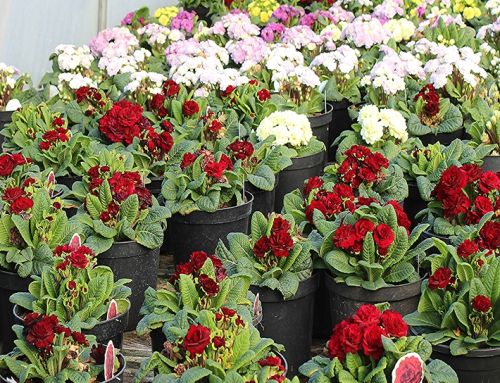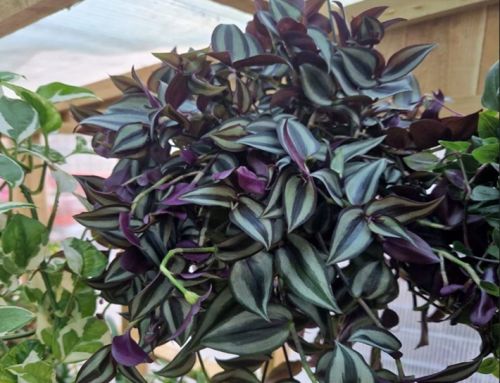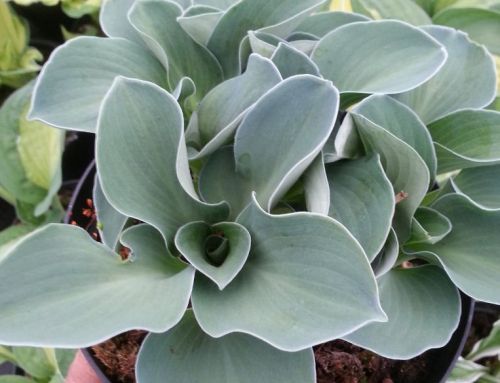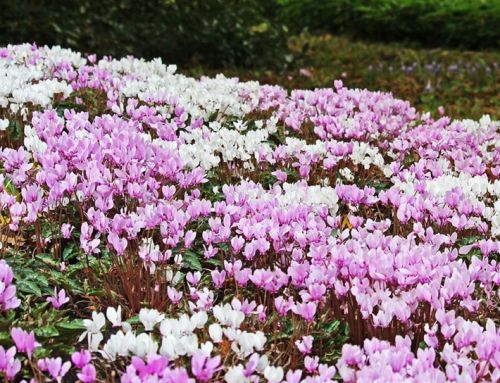Sarracenia – The Pitcher Plants
Sarracenia – Insect eating plants…… Sounds scary? Exciting? Certainly interesting and intriguing! To fully understand these remarkable plants and their unique adaptations it is necessary to go back to the lands where they originate. Almost all pitcher plants come from the eastern areas of North America.
Here the ground is wet, sunny, acidic and lacking in nutrients. To enable these amazing plants to survive and flourish an evolutionary sidestep was called for. As we all know plants need Nitrogen in order to grow, and, as the land they grew in was almost totally lacking in this, other methods of acquiring this precious element were needed. The leaves grew tall and cylindrical, forming ‘pitchers’ which trapped most flying insects. Many incredible features were utilised. These include slippery surfaces, downward pointing hairs, scent and colour to lure the unwitting prey into their floral prison. Once trapped digestive enzymes released the nutrients for absorption by the plants. The Sarracenias had arrived!!!
Carnivorous plants (Sarracenia) at Farmyard Nurseries
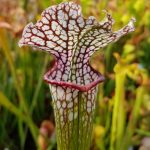
Housed in their own poly tunnel everyone is welcome to come and marvel at these beautiful, exotic and very unusual plants, many very rare and hard to get hold of.
The Sarracenia collection is increasing rapidly with more types being added weekly. Currently we have approaching 300 species and cultivars including 150 inter species hybrids. Most of the Sarracenias 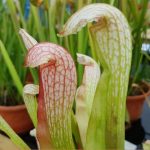
How to grow Sarracenia!
Maybe, like myself, you are aware of these plants but Sarracenia seem to be surrounded by an air of mystique…. Something that only the experts can grow, a rather expensive plant that you may kill in its first season.You may well be right, I certainly killed my first Sarracenia purpurea, mainly through neglect I think.
This belief could not be further from the truth. Actually they are amongst the easiest and most fascinating plants to grow. Not only do they increase (albeit slowly) year on year but they will last almost forever. They never need feeding and re potting is a rare occurrence. So how easy can it be!
There are just one or two golden rules that cannot be broken!!
Rules
Firstly during the growing season they MUST NEVER be allowed to dry out. The water used must be soft such as rain water, some spring waters or distilled water. Tap water will eventually kill them.
Secondly the compost that they are potted into should be acidic. This is usually peat often with the addition of sand or perlite. We use a mix of 50% medium/coarse peat and 50% top grade perlite. No nutrients whatsoever should be incorporated.
Finally they, on the whole, should be grown in a sunny but not scorchingly hot place.
This takes us back to where we started, they grow in nutrient-less bogs. Mimicking their natural growing conditions are best for most plants.
So to recap, plant Sarracenias in relatively small pots (a 2 litre container is more than adequate for the first few years) in a mixture of 50% peat and perlite. Stand the plant in about 2 cm. of soft water during the growing season and never allow to dry out. Place in a well lit situation (conservatories or sunny window sills are good too) and let them catch flies to their hearts content.
How to increase your plants
Division
Increasing your Sarracenia plants, again, couldn’t be easier. In essence all you do is remove the pot, wash most of the compost from the roots. Then break the plant into as many pieces as you want. Even the smallest pieces will produce fine plants. Believe me I have bought some shockers from the internet at exorbitant prices and even these tiny pieces have grown nicely. Once this has been done pot into the usual compost. Water well and let them do their own thing in the above growing conditions. While this can be done at any time between March and August I have found that March/April is ideal. The pitchers and the flowers have yet to emerge and therefore don’t get damaged. This leaves them to grow away happily and become established before the winter dormant period.
Seed
Slightly more challenging and certainly not for the impatient. Seed is the most fascinating and rewarding way to massively boost your collection. It does however come with one major drawback – it takes years to get a flowering plant. This aside, watching these miniature carnivores grow with their minute pitchers is totally enthralling and magical beyond belief.
Don’t believe what some people say, you don’t need special conditions really and there is no need to stratify the seed.
For the first time in 2018 I decided to have a bash. Crawling through countless plants gathering seed willy nilly, I collected more than I could ever grow…. If they all germinated I was in a mess. Every flower had been pollinated and produced hundreds of seed. I chose the best colours and forms and put them in envelopes. They then went into the office, never to be seen again.
Suddenly one day in early May I remembered them…. if only I had a brain!! I had intended to give them a cold treatment, but hey ho lets just sow them. Its too late to put them in the fridge now. I sprinkled the seed on the surface of the usual compost. Then I just added a very light dusting on top (not enough to cover them, as the books say!) Placing them in the same water as the parent plants I waited, eagerly looking every day for signs of life. 4 weeks later they are up and away. Could be beginners luck but who cares. Now I have to deal with lots of seedlings, all slightly different and with no real knowledge of parentage. I’m sure the purists will ostracise me for this irresponsible act!
If you’re really hooked why not join the Carnivorous Plant Society
There is also a lot of information available at www.sarracenia.co.uk with information on how to care for your Sarracenias and how to pollinate them, take a look at his seed grown Sarracenia collection, they really are something special!
Possible reading for you.
- The Savage Garden, by Peter D’Amato. In my opinion, this is the single best book on carnivorous plants you can buy today. Its chapters on Sarracenia are brilliantly detailed yet still accessible by beginners. Available on Amazon.
- Sarracenia.com, by Barry Rice. Barry’s FAQ is one of the oldest and most authoritative resources on carnivorous plants on the web. Geared around science and conservation, it’s well worth bookmarking. Link.
- Sarracenia Northwest, based in Oregon, are a carnivorous plant nursery with an excellent YouTube channel. Jacob offers seasonal growing tips and helpful tutorials, and I highly recommend subscribing.



